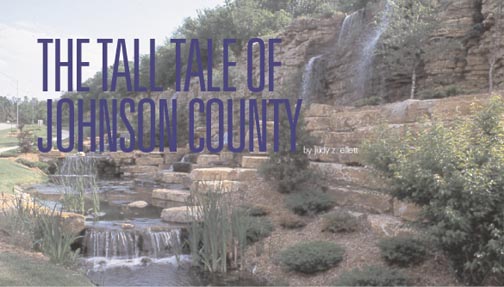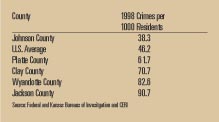
It’s
going on about 30 years now that radio listeners have been tuning in to
a show called “A Prairie Home Companion.” For two hours a week,
they listen to Garrison Keillor spin yarns about Lake Woebegone, a ‘little
town that time forgot, and the decades cannot improve.” The citizens
there are a sturdy lot, with names like Nils and Lars, and they’re
usually connected to farming somehow. Lake Woebegone, Keillor says fondly,
is a place “where the women are strong, the men are good looking,
and the children are above average.”
There’s another community on the prairie—right here in our Kansas
City metropolitan area as a matter of fact—that could inspire some
tall tales, except that everything you hear about it is true. The antithesis
of Lake Woebegone, it’s too dynamic to be contained in one town,
so we just call it Johnson County. Often described as “God’s
country” by its citizens, it is a place where the women are smart,
the men are successful and the children are darn-near perfect.
Half of Johnson County’s 477 square miles comprise a patchwork of
21 incorporated cities, and the other half offers room to grow. Unlike
the homogenous existence of Lake Woebegone, it’s a little tougher
to pinpoint a single Johnson County lifestyle because of the variety of
neighborhoods that fill the space from Westwood in the northeast corner
of the county to Edgerton in the southwest. Driving down State Line, you
can see the mansions of Missions Hills turn into the neat cottages of
Prairie Village to the rambling ranches of old Leawood back to the mansions
of Hallbrook. Traveling I-35 from north to south, you can watch vibrant
urban living meld into suburban ease then into small-town rural life in
a matter of minutes.
One thing is certain about Johnson County—with a sustained population
growth approaching 10,000 people a year, a per-capita income that ranks
above 98 percent of the nation’s counties, and a relatively low cost
of living, there’s plenty of discretionary income. The area’s
strong demographics attract retailers like ducks to a June bug from the
entrepreneurial establishments in the Fairway shops to the national chains
at Oak Park Mall. Stores and restaurants are moving south at a rapid rate,
but the densest band of new retail development lines 135th Street from
Leawood to Olathe. Of course, retailers are not the only ones to compete
for discretionary income—this same stretch of road is also becoming
known as Bankers’ Row.
When the judge asked the crook why he robbed banks, the criminal answered
logically, “Because that’s where the money is.” To follow
that logic would lead to the conclusion that Johnson County’s wealth
must attract crime, but nothing could be further from the truth. In most
large metropolitan areas, crime rates are typically higher than the national
average in counties with larger populations. This is true of Platte, Clay,
Wyandotte, and Jackson counties in Kansas City’s core five counties.
Johnson County’s crime rate is the only one lower than the national
average despite it’s 2000 population of 451,000, second only to Jackson
County’s 655,000.

Low crime rates and superior education have contributed to Johnson County’s
recognition as one of the best places to raise a family. Another factor
is the number of kid-friendly attractions the county offers. Children
and adults alike can visit the Deanna Rose Children’s Farmstead at
13800 Switzer to understand what it was like to live on a family farm
at the turn of the century—the 20th century, not the 21st. Demonstrations
and hands-on activities with crops and farm animals foster an appreciation
for a disappearing way of life.
Another family-oriented asset of the county and the entire Kansas City
region is the Overland Park Arbor-etum and Botanical Gardens on 179th
Street west of U.S. Highway 69. The 300-acre arboretum currently has eight
different ecosystems that have been identified with rare or unusual plant
species. The remainder of the project will be developed over the next
20 years and will eventually include traditional botanical gardens, an
education center, a visitors’ center and an 8,000-square-foot conservatory.
The arboretum is just a fraction of the green space being planned for
Johnson County. In September of 1999, the Johnson County Park and Recreation
District developed a Master Action Plan—MAP 2020—that will guide
new park development. Of the district’s 6,396 acres of parkland,
only 20 percent have been developed for recreation activities so far.
That development includes athletic fields, aquatic facilities, marinas,
beaches, nature centers and, of course, golf courses.
Johnson Countians love their golf, and they have 25 courses to choose
from, both public and private. Courses include designs by Tom Watson,
Jim Colbert, Tom Fazio, Robert Trent Jones II, and Tom Weiskopf. The newest
is the Nicklaus (as in Jack) Golf Club at Lionsgate.
The county offers not only outdoor sports, but outdoor culture as well,
including Art in the Woods, the Corporate Woods Jazz Festival and the
Shawnee Mission Park’s Theater in the Park. Not all Johnson County
culture takes place out of doors, however. The area provides a number
of attractions from Broadway – style shows and musicals at the New
Theatre to performances by local, national and international artists at
Johnson County Community College’s exceptional Carlsen Center.
Johnson County has museums, too, even if it does seem to be a place with
more in its future than in its past. As if to emphasize how young the
county is, relatively speaking, the Johnson County Museums are surveying
all pre-‘50s structures in the county as part of a larger project
to document historical architectural resources in the state of Kansas.
Not pre-1850 structures, mind you, but pre-1950. One of the attractions
at the Johnson County Museum of History at Shawnee Mission Parkway and
Lackman Road is the 1950s All-Electric Model House. The house, originally
built by the Kansas City Power and Light Company in Prairie Village to
exhibit all-electric living, is one of the few surviving exhibition homes
that were popular in the 1950s.
Just as it was in the 1950s, everything is up-to-date in Johnson County
in the 21st century. Predictions call for continued growth over the long
term in population, wealth and educated work force. Johnson County truly
is a place where the women are smart, the men are successful, and the
children are darn-near perfect.